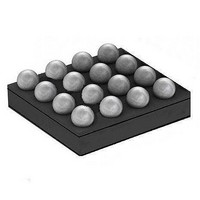MAX15051EWE+T Maxim Integrated Products, MAX15051EWE+T Datasheet - Page 13

MAX15051EWE+T
Manufacturer Part Number
MAX15051EWE+T
Description
Switching Converters, Regulators & Controllers 4A DC/DC CONVTR egulator with Integr
Manufacturer
Maxim Integrated Products
Datasheet
1.MAX15050EWET.pdf
(15 pages)
Specifications of MAX15051EWE+T
Output Current
4 A
Input Voltage
2.9 V to 5.5 V
Switching Frequency
1 MHz
Operating Temperature Range
- 40 C to + 85 C
Mounting Style
SMD/SMT
Duty Cycle (max)
96 %
Package / Case
WLP-16
Lead Free Status / RoHS Status
Lead free / RoHS Compliant
The above equations are based on the assumptions that
C1 >> C2, and R3 >> R2, which are true in most appli-
cations. Placements of these poles and zeros are deter-
mined by the frequencies of the double pole and ESR
zero of the power transfer function. It is also a function
of the desired closed-loop bandwidth. The following
section outlines the step-by-step design procedure to
calculate the required compensation components for
the MAX15050/MAX15051.
The output voltage is determined by:
where V
or 0.6V depending whether or not an external reference
voltage is applied to REFIN/SS.
For V
The zero-cross frequency of the closed-loop, f
be between 10% and 20% of the switching frequency,
f
faster transient response. Once f
culated from the following equation:
where V
with Integrated Switches in 2mm x 2mm Package
Figure 4. Type III Compensation Network
S
High-Efficiency, 4A, 1MHz, Step-Down Regulators
(1MHz). A higher zero-cross frequency results in
OUT
P-P
FB
MAX15050
MAX15051
= V
is the feedback voltage equal to V
= 1V
FB
C
1
COMP
, R4 is not needed.
P-P
=
LX
FB
f
P
2
f
______________________________________________________________________________________
P
2 _
R
3
x
(typ).
4
_
EA
π
EA
=
1 5625
x R x
.
(
=
V
L
=
3
OUT
V
R1
2
2
FB
π
C2
π
⎛
⎝ ⎜
(
C
V
1
x R
x
×
V
OUT
−
P P
+
IN
C1
C
R R x C
−
R
V
1
1
R
R
2
1
3
FB
is chosen, C1 is cal-
O
L
⎞
⎠ ⎟
x C
)
)
×
2
f
3
C
R3
R4
C
REFIN/SS
, should
V
OUT
R2
C3
Due to the underdamped nature of the output LC double
pole, set the two zero frequencies of the type III compen-
sation less than the LC double-pole frequency to provide
adequate phase boost. Set the two zero frequencies to
80% of the LC double-pole frequency. Hence:
Setting the second compensation pole, f
f
Set the third compensation pole at 1/2 of the switching
frequency (500kHz) to gain phase margin. Calculate
C2 as follows:
The above equations provide accurate compensation
when the zero-cross frequency is significantly higher
than the double-pole frequency. When the zero-cross
frequency is near the double-pole frequency, the actual
zero-cross frequency is higher than the calculated fre-
quency. In this case, lowering the value of R1 reduces
the zero-cross frequency. Also, set the third pole of the
type III compensation close to the switching frequency
(1MHz) if the zero-cross frequency is above 200kHz to
boost the phase margin. The recommended range for
R3 is 2kΩ to 10kΩ. Note that the loop compensation
remains unchanged if only R4’s resistance is altered to
set different outputs.
Figure 5. Type III Compensation Illustration
Z_ESR
yields:
C
GAIN (dB)
R
3
1
=
=
0 8
0 8
.
.
POWER-STAGE
1
x R
1
x C
TRANSFER
FUNCTION
COMPENSATION
TRANSFER
FUNCTION
C
3
FIRST AND SECOND ZEROS
2
R
1
2
x
=
x
=
FREQUENCY (Hz)
π
DOUBLE POLE
C
L x C
L x C
x R x f
O
C
x ESR
1
1
3
O
O
R
R
L
x R
L
x R
S
+
(
OPEN-LOOP
SECOND
+
(
POLE
R
R
O
GAIN
O
O
O
THIRD
POLE
+
+
ESR
ESR
)
P2_EA
)
, at
13







